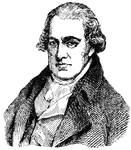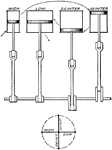
Quadruple Expansion Engine Piston
A piston system from a quadruple expansion engine showing the movement of steam. Steam first enters…
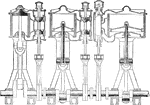
Piston of a Triple Expansion Steam Engine
A piston diagram from a triple expansion steam engine. The three cylinders are designed at high, medium,…

Plan of 1802 Trevithick Steam Carriage
A mechanical plan of 1802 Trevithick's Steam Carriage. The piston, operated by steam, is connected to…
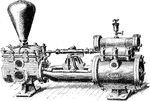
Direct Acting Steam Pump
"The direct—acting steam pump has the steam piston at one end of a rod and the water position…
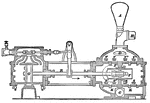
Steam Pump
A typical steam pump. A steam pump is a force pump operated by steam acting on the pistons of a steam…
Steam Engine Valve with Lap Connected to Rocker
"This occurs in horizontal engines when the valve is set on top of the cylinder instead of on one side.…

Shaft in an Eccentric Motion from Steam Engine
"As the eccentric turns in the strap, the point O moves in the dotted circle around O', and the point…

Valve with Lap of Steam Engine at Extreme Left with Exhaust Ports Open
"Since the valve must move a distance equal to the outside lap before admission can take place, it is…

Steam Apparatus
Side view of a steam apparatus constructed by Stephen Hoyt's Sons, New Canaan, Conn.

Steam Boiler
A boiler or steam generator is a device used to create steam by applying heat energy to water. Although…

Steam Engine
A machine for utilizing the elastic force of steam as a motive power, and now constructed in a variety…
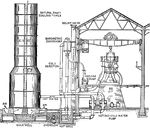
Steam Engine
Cross-section of a steam engine plant with Alberger barometric condenser and cooling tower.

Steam Engine
"An engine designed to throw a continuous stream of water through a hose upon a conflagration, for the…

Steam Engine Valve with Lap Steam Where Slide Valve is Closed
"The relative positions of crank, eccentric and valve when the exhaust closes on the crank end and compression…

Steam Engine Valve with Lap Where Steam is Admitted to the Slide Valve
"While the crank is moving from the position, steam is being admitted to the head end and being exhausted…

Steam Engine Valve with Lap Steam Where Slide Valve is in Open Position
An illustration of the valve with lap at the end of the crank end steam compression. The piston will…

Steam Engine Valve with Lap Steam Where Slide Valve Moved to Open Position
"If the inside lap is increased, the valve must move farther before released occurs and the crank angle…

Cross Compound Steam Engine
Illustration of a cross compound steam engine. The engine is designed to hold pressure until the engine's…
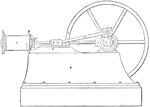
Low Power Simple Steam Engine Diagram
A low power steam engine. The piston inside cylinder A moves the wheel, generating power at 100 horsepower…

Low Power Simple Expansion Steam Engine
A low power simple expansion steam engine. The steam engine can run at 100 horsepower, and not run continuously.…
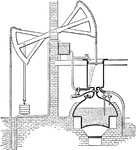
Newcomen Atmospheric Steam Engine
An illustration of Newcomen atmospheric steam engine. The boiler heats the water to build up steam in…
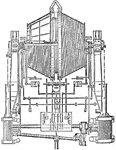
Plan of Direct Acting Hoisting Machine with Corliss Steam Engines for Mining
A plan of direct acting hoisting machine for mining industry. The machine is operated by compound Corliss…
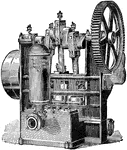
Power Pump Steam Engine
A power pump steam engine without shaft. The engine turns the wheel with the reciprocal motion of the…
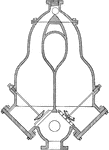
Pulsometer from Steam Engine
"A modification of Savery's engine, the pulsometer, is still quite common. It is used in places where…

Steam Engine Rocker Arrangement with Valve and Reverse Rod in Eccentric Motion
"This arrangement makes it possible to place the valve and steam chest above the valve motion. A rod…
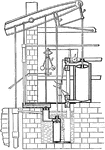
Watt's Final Steam Engine Design
The illustration showing Watt's final steam engine design. The engine is fitted with series of rods…
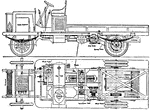
Steam Operated Tractor with Outside Spring Suspension
A tractor compound steam engine with outside suspension spring. The spring suspension helps stabilize…

9000 Kilowatts Vertical Curtis Turbine
An illustration of 9000 kilowatts capacity vertical Curtis turbine. Each turbines are located between…
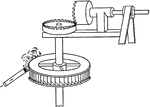
Branca's Impulse Steam Turbine
"In 1629, Branca, an Italian, invented a turbine much like a miniature water wheel, which was driven…

Westinghouse Parsons Turbine Viewed Cross Sectionally
A cross sectional view of Westinghouse Parsons turbine. Steam enters at V and exits at E, turning the…
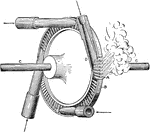
De Laval Steam Turbine
A De Laval steam turbine. The turbine is operated by supplying steam into the four nozzles. The steam…

Early Parsons Steam Turbine
"In 1885, Parsons took out his first turbine patent on a motor along the lines previously suggested…

Hartman's Compound Impulse Turbine
"In 1858, Hartman Bros. patented a turbine consisting of two revolving disks c and c' fixed to a shaft…
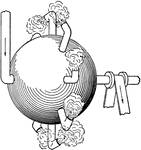
Hero's Simple Steam Turbine
A simple steam turbine by Hero of Alexandra during first century AD. The turbine consists of a hollow…

Sectional View of Kerr Turbine
"The shaft, where it passes through the diaphragm, is fitted to a bronze bushing with a few thousandths…
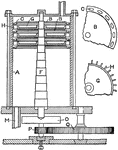
Real and Pichon Compound Steam Turbine
"A compound turbine was patented by Real and Pichon, the idea being to reduce the velocity of rotating…
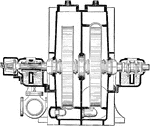
Cross Sectional View of Two Stage Condensing Terry Steam Engine Turbine
A two stage condensing Terry turbine from a steam engine. The steam, entering from the top, rotates…

Wilson's Compound Steam Turbine
"A view of Wilson's invention is shown; a, b, and c, are vance which are attached to and rotate with…

Valve with Lap of Steam Engine Where Steam Enters the Slide Valve Compartment
"The maximum displacement of the valve is attained when the eccentric is horizontal. In this position…
D Valve
"A valve for opening and closing the induction and eduction passages of a steam-engine cylinder: so…

D Valve
"A valve for opening and closing the induction and eduction passages of a steam-engine cylinder: so…

Slide Valve of Steam Engine
"The amount that the valve overlaps the steam ports is called the lap of the valve. It will at once…
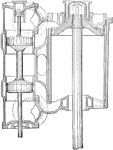
Cross Sectional View of the High Pressure Cylinder of Piston Valve from USS Massachusetts
"This valve consists of two pistons connected by a sleeve through which the valve rod passes. This valve…
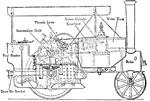
Side and Inside View of Steam Operated Vehicle
A side and inside view of the superheated steam vehicle. Water is heated by a heat transferred by the…

Two Vessels from Thomas Savery First Steam Engine
Two vessels from the Thomas Savery first steam engine. The right tank fills up with water while the…

Steam Wagon with Two Side Chains Transmitting Drive
An illustration of a steam wagon with a transmission with two side chains. The boiler is located on…

Steam Wagon with Single Chain Transmitting Drive
A steam wagon with single chain, connecting the back wheels to the differential gear. The engine is…

Wagon with Steam Engine and Transmission Gearing with Double Helical Gear
"The transmission on the first type of vehicle is by means of gearing throughout, and is completely…

Steam Operated Wagon with Transmission Gearing with Double Helical Gear
A steam operated wagon with two speed gear. The gears are located at the intermediate shaft, moving…

Yorkshire Steam Wagon Patent
A Yorkshire steam wagon patent with unique boiler construction. The wagon operates with the drive chain…

Water Jet Deflected 90 Degrees Measuring Force
"If the velocity of impact of the jet is V feet per second, its velocity in the same direction after…
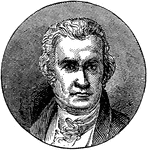
James Watts
James Watt (19 January 1736 – 25 August 1819) was a Scottish inventor and mechanical engineer…

